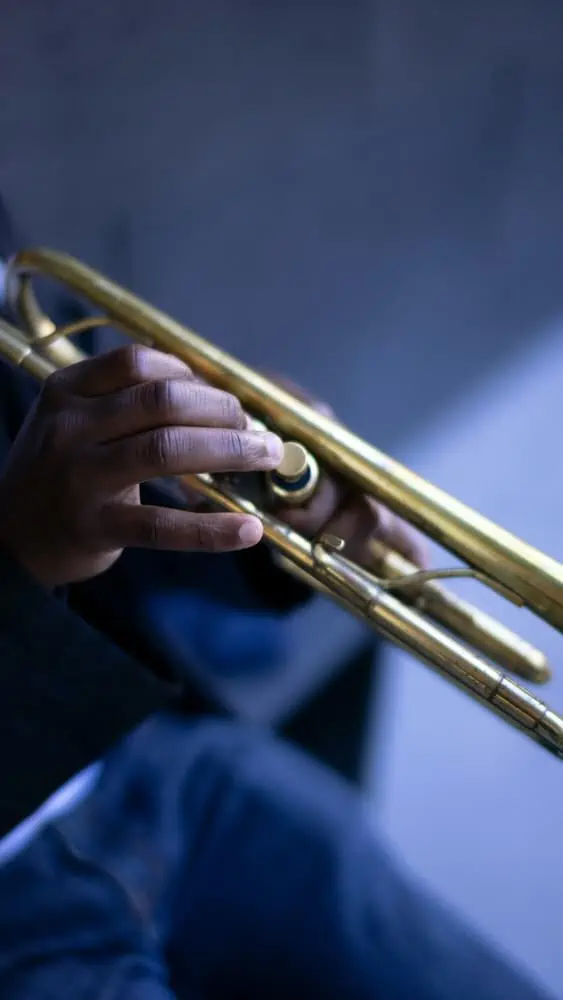The lively sound of the *trumpet* and *trombone* has always amazed me. The masters of this craft inspired me to pick a path that *tugs at my heart* and keeps me spellbound by the efforts of my teachers and friends.
And in this journey, the breathing exercises have played a big role. Embarking on the quest for breath control mastery, I will explore the nuances that have defined legendary brass musicians. Beyond the technicalities, we explore the secrets of greats like Miles Davis, Wynton Marsalis, and Maynard Ferguson.
We will uncover the techniques and exercises that propelled them to brass instrument immortality. These breathing exercises for musicians will help you in mastering the art like these famous legends.
Awareness of breath - In the footsteps of legends

Understanding the mechanics of breath is the first crucial step in elevating your breath control. When we inhale, our lower ribs expand around the body, creating a foundation for controlled exhalation.
To deepen this awareness, place your hands around your lower ribs, feeling the expansion and contraction. Take it a step further by lying down and placing a pillow or book on your abdomen, visually observing its rise and fall with each breath. The diaphragm is a central player in the breath control symphony. It presses downward during inhalation and relaxes during exhalation. Delve into the sensation of this downward push, especially when aiming for the deepest breath possible. Developing this awareness establishes a solid groundwork for advanced breath control techniques.
As we hone our awareness of breath, we draw inspiration from iconic musicians who elevated this fundamental skill. Miles Davis, the trumpet virtuoso, was known for his distinctive sound and melodic improvisation. His secret?
A deep understanding of breath control allowed him to weave intricate musical tales effortlessly.

Try this one of the top trumpet breathing exercises: Visualize yourself standing on the stage with the same poise as Miles Davis.
Embrace the expansion and contraction of your lower ribs, mirroring the rhythmic rise and fall of his trumpet phrases.
The resonance of your notes will echo the timeless mastery of a jazz legend.
When you are a student who has a deep interest in playing musical instruments, challenges are many. Getting the balance right so that your academics don’t suffer is the key. You want to master the music instruments and also do great in academics so you should look for writing services that can do the homework for you on time.
Having education help during school is important, mainly due to the endless writing assignments you have to tackle. With help online, you can pursue your dream of excelling as a musician. You can practice these breathing exercises with a free mind, without being concerned about the time factor.
Intake of Breath - Unveiling the Miles Davis technique

The ability to take in substantial air in a single breath is a fundamental skill for wind instrumentalists. Musical phrases often demand extended breaths akin to a swimmer completing a lap underwater. To cultivate this skill, adopt the habit of opening your throat like a yawn during inhalation, envisioning the syllable “OH” to ensure a quiet and efficient air intake.
Imagine the impact on your playing when, instead of a mere “cup” of air, you learn to inhale a “liter” each time. This adjustment not only enhances your breath capacity but also contributes to the overall resonance and sustainability of your musical phrases.
Miles Davis was a pioneer in extended breath techniques, a skill evident in his ability to sustain long, expressive phrases. Emulate his approach by practicing intentional, deep breaths. Open your throat wide, channeling the essence of Miles’ timeless classic, “So What.” Inhale with the syllable “OH,” unlocking the potential for voluminous breath intake.
Picture yourself in Miles Davis’ world, where each breath fuels the creation of musical landscapes. Extend your inhalation capacity, envisioning the vastness of a serene lake, mirroring the tranquil expanses explored in Davis’ “Kind of Blue.”
Long note practice - Wynton Marsalis' blueprint

Long note practice serves as a powerful tool for honing breath control. By playing a sustained note for a specific duration, you not only build stamina but also refine the evenness and control of your sound. Engage in exercises where you play a note for, let’s say, 8 seconds, take a deliberate breath for 1 second, and proceed to another note for 8 seconds.
Tailor the length of your notes to your proficiency level. Adjust the duration to challenge yourself progressively. This practice not only enhances breath control but also instills a sense of rhythmic precision into your playing, a valuable skill in musical expression.
Transitioning to long note practice, we find inspiration in the discipline of Wynton Marsalis, a modern-day trumpet virtuoso. His commitment to precision and control is a testament to the transformative power of deliberate, sustained notes.
Engage in Wynton-inspired exercises: Consider this as a sort of breathing gym. Choose a passage from a challenging piece and play a single note for an extended duration, focusing on evenness and controlled dynamics. Embrace the meditative quality of this practice, connecting with the essence of Wynton’s meticulous approach to craft. And while listening to music for breathing exercises, you can do these even better.
Breathing and posture - The Stan Kenton legacy

Maintaining proper posture is a crucial element in enabling controlled inhalation and ensuring a smooth, quiet breath intake. This makes you better at doing breath support exercises. Visualize a straight spine, relax your shoulders, and open your throat in a yawn-like manner. A conscious effort towards achieving and sustaining good posture enhances your overall breath control and contributes to a more effortless playing experience.
Stan Kenton, a trailblazer in the world of big band jazz, understood the symbiotic relationship between posture and breath control. As you maintain a straight spine, channel the authoritative posture of Kenton leading his orchestra. Visualize the grandeur of a Kenton performance, where posture isn’t just a physical stance but a conduit for controlled inhalation and exhalation.
While you play the breathing music, incorporate a yawn-like throat opening into your posture. Emulate the ease with which Kenton navigated the intricate tapestry of his musical arrangements.
Breathing and phrasing - The artistry of Arturo Sandoval

Breathing is not a mere technicality. It’s an integral part of the music itself and makes respirations instrumental sound better. Marking breaths on your sheet music serves as a roadmap, guiding you through each phrase. By understanding how far you need to go for each phrase, you become more aware of the amount of air required.
Treat breaths as punctuation marks in the musical narrative. Just as a well-placed comma or period shapes the flow of a sentence, strategically placed breaths influence the shape of your musical phrases. By making breaths an integral part of your playing, you not only enhance control but also contribute to the overall musicality of your performance.
Arturo Sandoval, a living trumpet legend, masterfully integrates breath into his phrasing. Mark your sheet music with breath indicators, a technique borrowed from Sandoval’s playbook. Transform your musical narrative, treating breaths as punctuation marks that shape the contour of each phrase.
Imagine yourself on stage with Sandoval. You need great breath support to play like the maestro. Here, every breath becomes a deliberate stroke on the canvas of your musical expression. It creates a masterpiece that echoes his virtuosity.
Breathing Exercises to Concentrate Better – For Brass Musicians
Summary
To have wind instrument mastery, breath control emerges as a symphony conductor. It orchestrates the notes, nuances, and legacies of iconic musicians.
Use the techniques of Miles, Wynton, Maynard, Stan, Arturo, and more, infusing their wisdom into your practice. As you master the art of breath control, envision yourself standing on the shoulders of these legends. Feel them contributing your unique notes to the ever-evolving melody of musical expression.
The secrets are unveiled, the exercises laid bare – now, breathe life into your musical journey. Let the symphony of wind instruments resonate with your own unique cadence. Happy playing!











If only breathing exercises could help me with my daughter’s practice sessions. Might need noise control more than breath control!
I’ve spent a lot of time marking breaths on my sheet music, but it’s interesting to see the concept highlighted in an article. It makes me wonder about the different approaches between wind instruments like the clarinet and brass instruments. The nuances in breath control across the board are fascinating, and it’s intriguing to think about how these techniques can be applied universally or need to be adapted to fit the specific needs of an instrument or musician.
i always struggle with breathing right when i play and this article kinda makes sense. gonna try marking breaths on my sheet music like Arturo Sandoval does. not sure if itll help but worth a shot, thanks robert emery.
Long note practice, huh? More like practicing how to not pass out, am I right? But really, sustaining notes is a game-changer. Makes all the difference when you’re aiming for that smooth sound.
I’ve always admired the way great musicians seem to have endless breath for their melodies. This article breaks down the process in a way that’s accessible and insightful. It’s fascinating how posture and breath control work hand in hand. I hadn’t considered the impact of posture on breathing capacity before. Excellent piece, Robert Emery!
Dude, the Miles Davis technique is a game-changer for me. Never thought about yawning to open the throat but it works wonders.
Yawning helps, right? Wait till you try it with faster pieces, challenges your control but it’s worth it.
The part about taking in a substantial amount of air really got me thinking. I’ve tried the yawning technique before, but sometimes I feel like it’s not as effective as it should be. Could it be the way I’m positioning my throat or maybe something else entirely? Would love some tips on refining this technique, maybe there’s something I’m missing out on. And hey, Robert Emery, any personal insights on mastering the ‘Miles Davis technique’ would be highly appreciated!
It might help focusing on diaphragmatic breathing too, really helped me along with the yawning technique!
I’ve had similar issues! Hoping someone clarifies. Struggling with sustaining longer phrases here.
Really liked the part about breathing and posture from the Stan Kenton section. Do you have more exercises that specifically help with posture while playing? It’s something I emphasize in my classes but always looking for new methods. Cheers, Robert Emery for the insights.